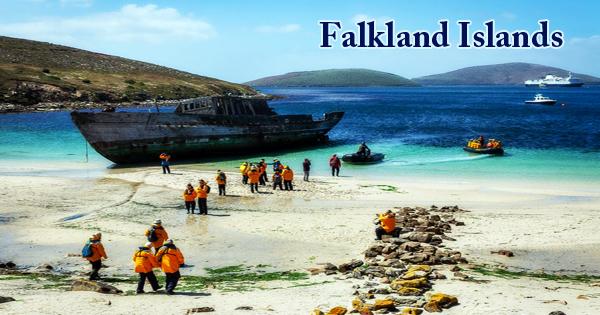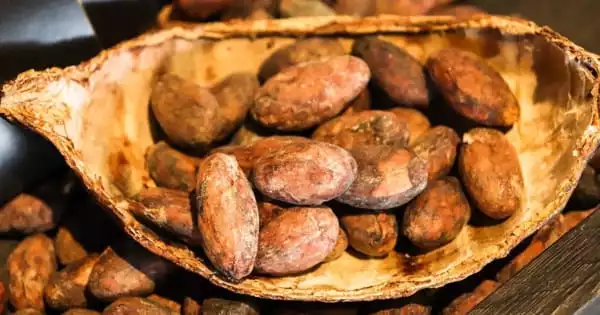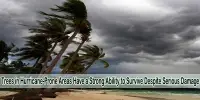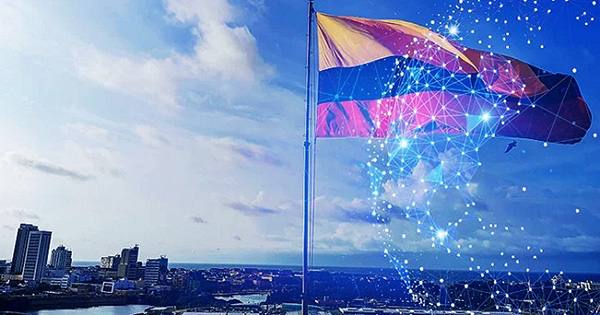The Falkland Islands (/ˈfɔːlklənd/; Spanish: Islas Malvinas, pronounced: ˈislas malˈβinas), the United Kingdom’s internal self-governing overseas territory in the South Atlantic Ocean. The main islands are located approximately 300 miles (483 kilometers) east of the southern Patagonian coast of South America and approximately 752 miles (1,210 kilometers) from the northern tip of the Antarctic Peninsula at a latitude of approximately 52°S. Stanley, on East Falkland, is the capital and main city; there are also some scattered small settlements and a Royal Air Force base located at Mount Pleasant, about 35 miles (56 km) southwest of Stanley. The archipelago includes East Falkland, West Falkland, and 776 smaller islands, with an area of 4,700 square miles (12,000 square kilometers).

(Stanley is the financial center of the Falkland Islands’ economy)
While much of the land found by European explorers during the Age of Discovery was already inhabited, until the mid-18th century no one lived on the Falkland Islands. The Falklands have internal self-governance as a British overseas territory, and the United Kingdom takes responsibility for their defense and foreign relations. The capital of the Falkland Islands is Stanley, East Falkland. No documents show anyone ever seeing the islands until 1592, when John Davis, an English captain of the sea, found them. Almost 100 years later, the first landing was made by another English sea captain, John Strong.
The islands are commonly known as Islas Malvinas in South America, since in 1764, early French settlers called them Malouines, or Malovines, after their homeport of Saint-Malo, France; Area 4,700 square miles (12,200 square km). There is debate about the discovery of the Falklands and subsequent settlement by Europeans. The islands also had French, British, Spanish, and Argentine settlements at different times. In 1833, Britain reaffirmed her constitution, but Argentina retains its claim to the islands. A resolution inviting Britain and Argentina to hold talks to find a negotiated solution to the conflict was accepted by the UN General Assembly in 1965. These protracted negotiations were still underway in February 1982, but the military government of Argentina invaded the Falklands on April 2. The war also left some 117 minefields, including anti-vehicle and anti-personnel mines, containing approximately 20,000 mines of different types.
Argentina’s leader, Leopoldo Galtieri, stepped down and was replaced by Carlos Menem. Menem called for United Kingdom-Argentina peace talks, and while the negotiations took some time, the dispute between the two countries officially ended in 1995. A new constitution came into force in January 2009, which strengthened the local democratic government of the Falklands and reserved the right for the islanders to decide the political status of the territory. Islanders voted almost unanimously in a referendum held in March 2013 to remain a British overseas territory.
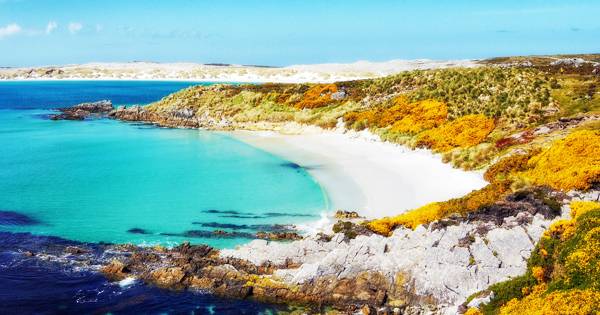
(Falkland Islands)
A land area of 4,700 square miles (12,000 km2) and a coastline measured at 800 miles (1,300 km) are the Falkland Islands. The two major islands, East Falkland and West Falkland, and about 200 smaller islands are about as extensive as the U.S. state of Connecticut in total land area. The islands are situated on the Patagonian Shelf in the South Atlantic Ocean, about 300 miles (480 km) east of southern Argentina’s Patagonia. The estimated position of the Falklands is 51°40′-53°00′ S latitude and 57°40′-62°00′ W longitude. The Falkland Islands government also administers South Georgia’s British overseas territories and the South Sandwich Islands, including the rocks of Shag and Clerke, which lie to the east and southeast of the Falklands from 700 to 2,000 miles (1,100 to 3,200 km).
The islands have a cold, windy and humid maritime climate. The variability of regular weather in the archipelago is typical. Rainfall in Stanley is widespread over half of the year, averaging 610 millimeters (24 in) and occasional light snowfall occurs almost year-round. An average of 19 miles (31 km per hour is reliably strong west winds, while the mean annual average temperature is around 42 °F (5 °C), with an average maximum of 49 °F (9 °C) and an average minimum of 37 °F (3 oC). It is normal to have strong westerly winds and gloomy skies. Although every month numerous storms are reported, conditions are usually calm.
The Falkland Islands are fully self-sufficient and almost self-governing today. People from all over the world have settled there to work in the lucrative farming and fishing industries of the island. In a landscape with no natural tree growth, the islands’ vegetation is low and dense. The grasslands are dominated by white grass (Cortaderia pilosa) and diddle-dee (Empetrum rubrum). Where livestock grazing has been managed, offshore islands are still covered by coastal tussock grass (Parodiochloa flabellata). Land birds make up much of the avifauna of the Falklands; 63 species, including 16 endemic species, breed on the islands. On the islands, there is abundant arthropod diversity as well. The flora of the Falklands consists of 163 vascular species native to them.
For several million penguins, mainly rockhopper, magellanic, and gentoo penguins with smaller numbers of king and macaroni penguins, the Falklands are breeding grounds. The only native terrestrial mammal of the islands, the Warrah, was hunted by European colonists to extinction. Dolphins and porpoises are common, and there are also numerous southern sea lions and elephant seals. At a few isolated sites, fur seals are found. In the waters surrounding the islands, squid are plentiful, but overfishing became a concern in the 1990s, and steps were taken to correct the problem. It is also a popular tourist destination, as there is a lot of unspoiled nature to explore and to learn about fascinating cities.
The Falkland Islands economy is ranked 222nd largest out of 229 by GDP (PPP) in the world but ranks 5th per capita by GDP (PPP) worldwide. The sheep stations (ranches) of the islands vary in size and may be owned by individual families or by Britain-based companies. On the islands, several hundred thousand sheep are kept, producing several thousand tons of wool every year as well as some mutton. Much of the Falkland Islands’ gross domestic product is accounted for by the primary sector of the economy, with the fishing industry alone contributing between 50 percent and 60 percent of annual GDP; agriculture also contributes significantly to GDP and employs about a tenth of the population. The wool is sold in Great Britain and is the leading land-based export from the Falklands. Beginning in the early 21st century, tourism, particularly ecotourism, grew rapidly to become another leading sector of the economy. Since the late 20th century, such efforts have allowed the economy of the islands to enjoy sustained growth.
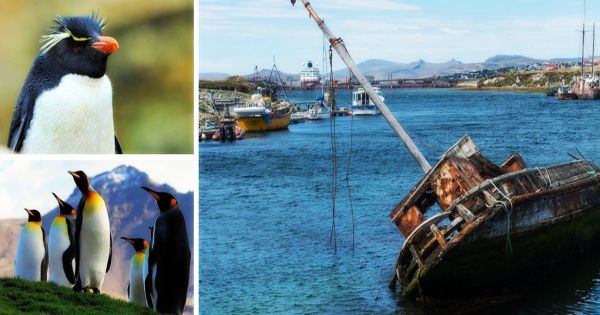
(Marguerita Melville, Karsten Bidstrup and Marsel van Oosten)
The archipelago’s wildlife and climate, as well as activities such as fishing and wreck diving, draw visitors, mainly cruise ship passengers; the majority find accommodation in Stanley. Just like Captain John Strong more than 300 years ago, today’s visitors to the Falkland Islands have the opportunity to spot a great range of indigenous wildlife, especially birds, during their outdoor excursions. On these sprawling islands, avian species are remarkably common, offering visitors a great opportunity to see some of the rarest and most fascinating birds in the world.
The culture of the Falklands is based on the cultural practices of its British founders, but Hispanic South America has also influenced it. In Stanley, where pubs, bright red mailboxes, and well-kept gardens are numerous, the British heritage of the islands is evident. English is the dominant and official language of the Falklands, with British English being the primary dialect; nonetheless, some inhabitants still speak Spanish. On the islands, sports activities are common and include bird-watching, fishing, and horseback riding.
Information Sources:
